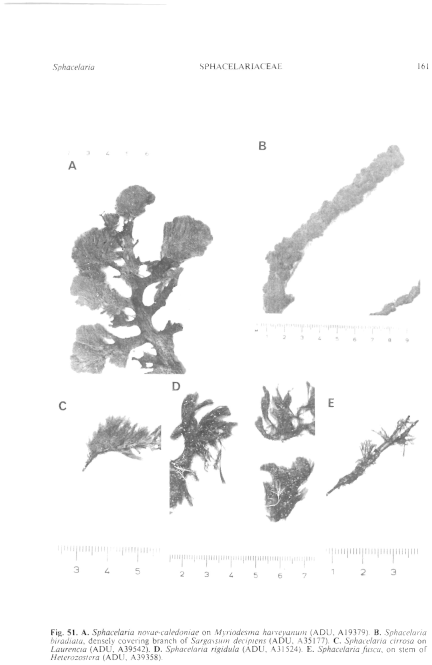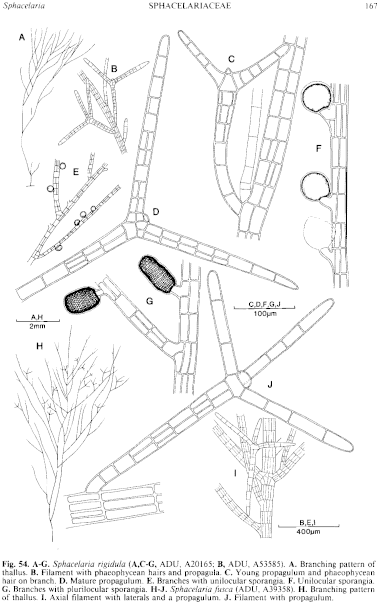|
|
|
|
|
|||||||||||
|
Electronic Flora of South Australia Species Fact Sheet
Phylum Phaeophyta – Order Sphacelariales – Family Sphacelariaceae
Selected citations: Prud'homme van Reine 1982: 203, figs 508–554.
Synonym
S. furcigera Kützing 1855: 27, pl. 90 fig. II. Goodband 1971: 957. van den Hoek & Flinterman 1968: 193, figs 1–150. Sauvageau 1900: 221 (R7); 1901: 379 (R145), fig. 35. Womersley 1967: 199.
Thallus (Figs 51D, 54A) medium to dark brown 0.3–1.5 (–3) cm long, forming erect penicillate tufts or cushions, epilithic or epiphytic on larger algae or seagrasses, arising from a discoid (usually monostromatic) or stoloniferous base. Branching (Fig. 54A,E) of erect filaments sparse to frequent, with indeterminate laterals arising irregularly and usually at narrow angles, and usually all growing to a similar height; phaeophycean hairs absent to abundant, 14–20 µm in diameter. Filaments (Fig. 54C,F,G) of similar diameter [(25–) 30–45 (–52) µm] throughout or tapering only slightly, with segments L/B (0.8–) 1.0–1.6 (–2.0) and showing 1–3 (–4) longitudinal walls; secondary transverse walls absent to very rare.
Reproduction: Propagula (Fig. 54B–D) mostly with 2 (–3) slender, cylindrical to slightly tapering arms each 150–350 (–450) µm long and 20–28 µm in diameter, borne on a pedicel 150–250 µm long and with a lenticular apical cell not developing into a hair; occasionally one arm may branch near its base. Unilocular sporangia (Fig. 54E,F) lateral, shortly pedicellate, subspherical, 40–55 (–70) µm in diameter. Sexual plants (van den Hoek & Flinterman 1968) forming either ovoid plurilocular macrogametangia, 50–120 (–200) µm long and 30–58 µm in diameter, or irregularly ovoid microgametangia 50–70 (–90) µm long and 33–50 (–68) µm in diameter. Australian plants with ovoid plurilocular organs (Fig. 54G), 50–70 µm long and 30–40 µm in diameter, with small loculi.
Type from the Red Sea, on Hormophysa triquetra (Schimper); holotype in L, 937,117 ... 229; isotype in W, 19682.
Selected specimens: Jacques Point, Kalbarri, W. Aust., on Caulocystis, upper sublittoral pools ( Womersley, 15.ix.1979; ADU, A51282). Point Valliant, Two People Bay, W. Aust., mid eulittoral pools (Womersley, 30.viii.1979; ADU, A50977-"Marine Algae of southern Australia" No. 192, as S. furcigera). Aldinga, S. Aust., on Cystoseira, outer reef pools (Womersley, 12.vii.1968; ADU, A32551). Flour Cask Bay, Kangaroo I., S. Aust., on Caulocystis ticllera. upper sublittoral pools ( Womersley, 12.ii.1956; ADU, A20165). Point Roadknight, Vic.. lower eulittoral pools ( Womersley, 22.i.1967; ADU, A31524). Walkerville. Vic., on Cladostenhus in pool (Sinkora .A2395, 27.ii.1978; ADU, A53585).
Distribution: Widespread in tropical to temperate seas.
From Kalbarri (at least), W. Aust., around southern Australia through N.S.W.; not recorded from Tasmania.
Taxonomic notes: S. rigidula is one of the commonest species of Sphacelaria on southern Australian coasts, and probably also occurs around tropical Australian coasts. It occurs both epilithic in rock pools and as an epiphyte on larger algae (especially Caulocystis) and on seagrasses. Propagula are usually present in summer but may be absent in winter when plurilocular or unilocular organs occur.
The slender, penicillate, filaments, increasing only slightly in diameter towards their base, forming dense, spreading, tufts of even height, with all filaments indeterminate in growth, separate most specimens clearly from S. fusca, but a few difficult-to-place specimens have been seen.
References:
GOODBAND, S.J. (1971). The taxonomy of Sphacelaria cirrosa (Roth) Ag., Sphacelaria fusca (Huds.) Ag., and Sphacelaria furcigera (Kuetz.) Sauv. A simple statistical approach. Ann. Bot. 35, 957–980.
KÜTZING, F.T. (1843). Phycologia generalis. (Leipzig.)
KÜTZING, F.T. (1855). Tabulae Phycologicae. Vol. 5. (Nordhausen.)
PRUD'HOMME VAN REINE, W.F. (1982). A taxonomic revision of the European Sphacelariaceae (Sphacelariales, Phaeophyceae). Leiden Botanical Series, Vol. 6. (Brill: Leiden.)
SAUVAGEAU, C. (1900–1914). Remarques sur les Sphacélariacées. This was published as follows: pp. 1–51, J. de Bot. 14 (1900); pp. 51–167, Ibid. 15 (1901); pp. 167–228, Ibid. 16 (1902); pp. 228–332, Ibid. 17 (1903); pp. 332–348, Ibid. 18 (1904); pp. 348–480? (1904) and pp. 481–634 (1914), separately published with the above reprinted, 1914. (Bordeaux.)
VAN DEN HOEK, C. & FLINTERMAN, A. (1968). The life history of Sphacelaria furcigera Kuetz. (Phaeophyceae). Blumea 16, 193–242.
WOMERSLEY, H.B.S. (1967). A critical survey of the marine algae of southern Australia. II. Phaeophyta. Aust. J. Bot. 15, 189–270.
The Marine Benthic Flora of Southern Australia Part II complete list of references.
Publication:
Womersley, H.B.S. (14 December, 1987)
The Marine Benthic Flora of Southern Australia
Part II
©Board of the Botanic Gardens and State Herbarium, Government of South Australia
Illustrations in Womersley Part II, 1997: FIGS 51D, 54 A–G.

Figure 51 enlarge
Fig. 51. A. Sphacelaria novae-caledoniae on Myriodesma harveyanum (ADU, A19379). B. Sphacelaria biradiata, densely covering branch of Sargassum decipiens (ADU, A35177). C. Sphacelaria cirrosa on Laurencea (ADU, A39542). D. Sphacelaria rigidula (ADU, A31524). E. Sphacelaria fusca, on stem of lieterozostera (ADU, A39358).

Figure 54 enlarge
Fig. 54. A–G. Sphacelaria rigidula ( A,C–G, ADU, A20165; B, ADU, A53585). A. Branching pattern of thallus. B. Filament with phaeophycean hairs and propagula. C. Young propagulum and phaeophycean hair on branch. D. Mature propagulum. E. Branches with unilocular sporangia. F. Unilocular sporangia. G. Branches with plurilocular sporangia. H–J. Sphacelaria fusca (ADU, A39358). H. Branching pattern of thallus. I. Axial filament with laterals and a propagulum. J. Filament with propagulum.

|
Email Contact: State Herbarium of South Australia |

|